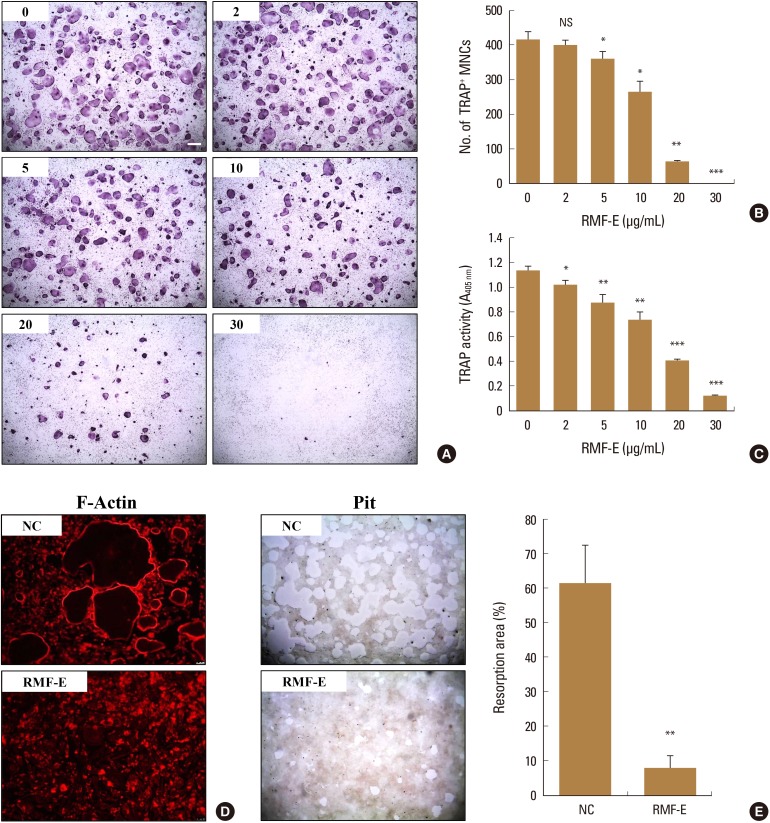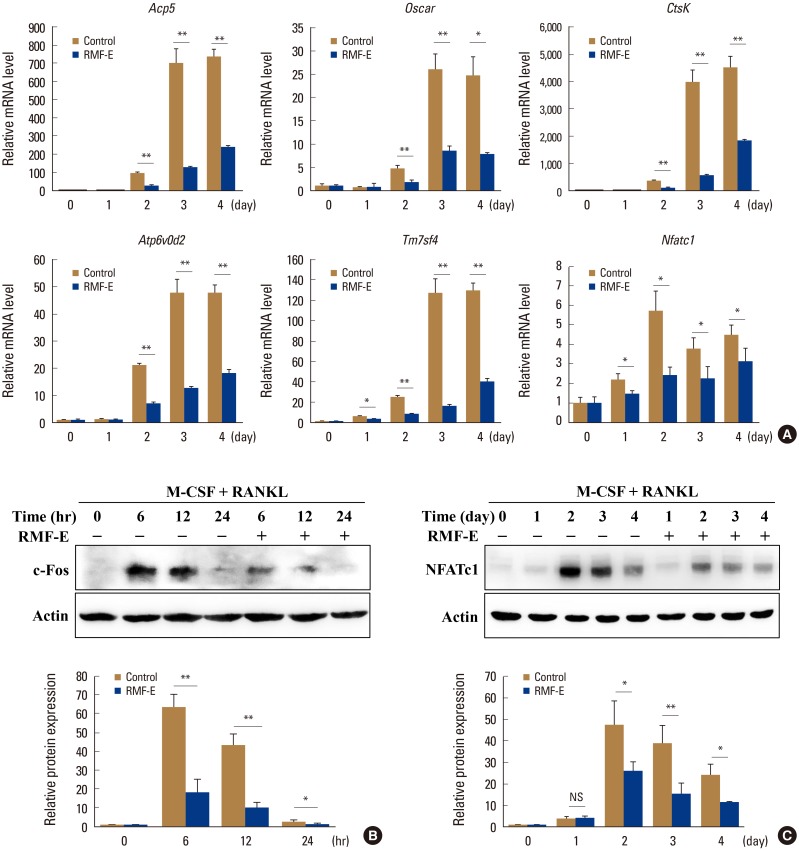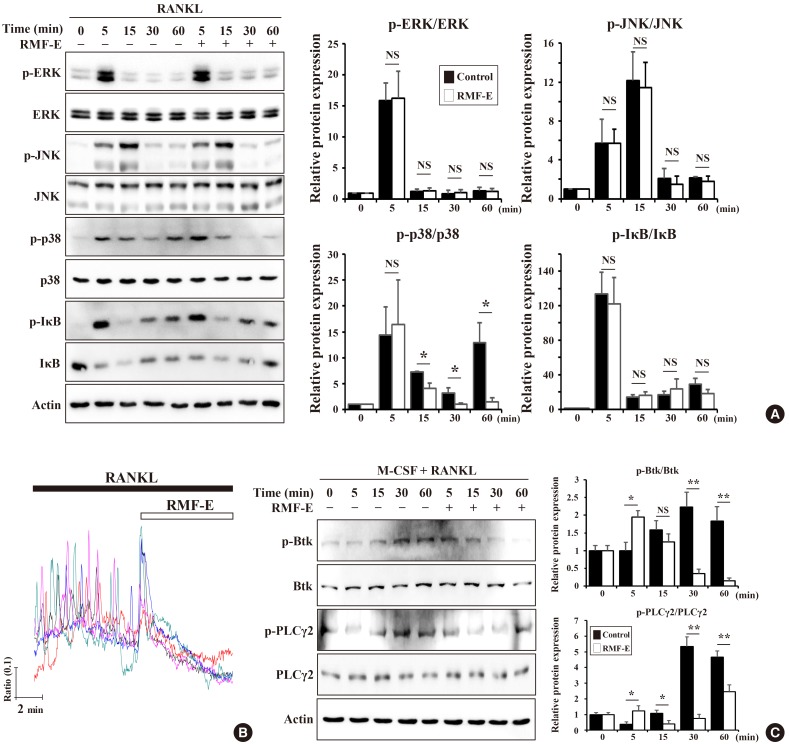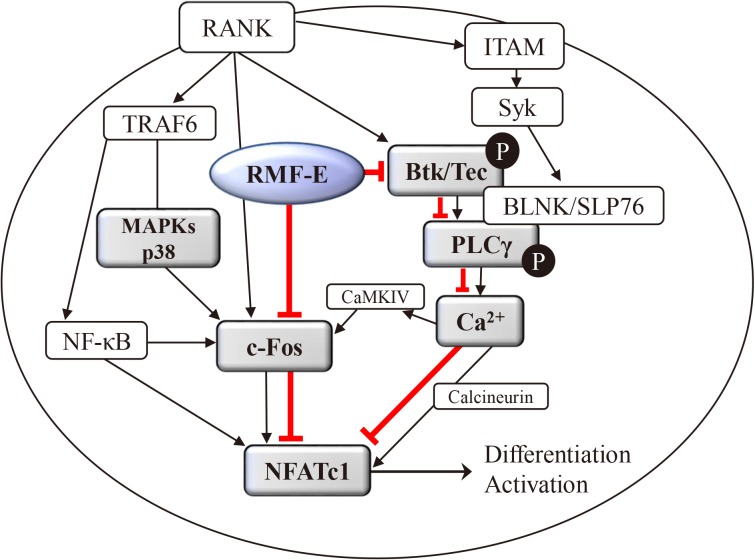1. Boyle WJ, Simonet WS, Lacey DL. Osteoclast differentiation and activation. Nature. 2003; 423:337–342. PMID:
12748652.

2. Walsh MC, Kim N, Kadono Y, et al. Osteoimmunology: interplay between the immune system and bone metabolism. Annu Rev Immunol. 2006; 24:33–63. PMID:
16551243.

3. Walsh MC, Choi Y. Biology of the RANKL-RANK-OPG system in immunity, bone, and beyond. Front Immunol. 2014; 5:511. PMID:
25368616.

4. Takayanagi H. Osteoimmunology: shared mechanisms and crosstalk between the immune and bone systems. Nat Rev Immunol. 2007; 7:292–304. PMID:
17380158.

5. Shinohara M, Koga T, Okamoto K, et al. Tyrosine kinases Btk and Tec regulate osteoclast differentiation by linking RANK and ITAM signals. Cell. 2008; 132:794–806. PMID:
18329366.

6. Lee SH, Kim T, Jeong D, et al. The tec family tyrosine kinase Btk Regulates RANKL-induced osteoclast maturation. J Biol Chem. 2008; 283:11526–11534. PMID:
18281276.

7. Negishi-Koga T, Takayanagi H. Ca2+-NFATc1 signaling is an essential axis of osteoclast differentiation. Immunol Rev. 2009; 231:241–256. PMID:
19754901.

8. Kim H, Kim T, Jeong BC, et al. Tmem64 modulates calcium signaling during RANKL-mediated osteoclast differentiation. Cell Metab. 2013; 17:249–260. PMID:
23395171.

9. Kim JH, Kim N. Regulation of NFATc1 in osteoclast differentiation. J Bone Metab. 2014; 21:233–241. PMID:
25489571.

10. Cheng BC, Ma XQ, Kwan HY, et al. A herbal formula consisting of Rosae Multiflorae Fructus and Lonicerae Japonicae Flos inhibits inflammatory mediators in LPS-stimulated RAW 264.7 macrophages. J Ethnopharmacol. 2014; 153:922–927. PMID:
24568773.

11. Cheng BC, Yu H, Guo H, et al. A herbal formula comprising Rosae Multiflorae Fructus and Lonicerae Japonicae Flos, attenuates collagen-induced arthritis and inhibits TLR4 signalling in rats. Sci Rep. 2016; 6:20042. PMID:
26860973.

12. Song CH, Bui TT, Piao CH, et al. Rosae Multiflorae fructus hot water extract inhibits a murine allergic asthma via the suppression of Th2 cytokine production and histamine release from mast cells. J Med Food. 2016; 19:853–859. PMID:
27574849.

13. Kitahiro Y, Ikeda H, Im HT, et al. Phytochemical characterization of Rosa multiflora Thunb. (Rosaceae) in Japan and South Korea, with a focus on the bioactive flavonol glycoside ‘multiflorin A’. J Nat Med. 2019; 73:555–565. PMID:
30949951.

14. Yi O, Jovel EM, Towers GH, et al. Antioxidant and antimicrobial activities of native Rosa sp. from British Columbia, Canada. Int J Food Sci Nutr. 2007; 58:178–189. PMID:
17514536.
15. Sacan O, Yanardag R. Purification and some properties of rose (Fructus cynosbati) hips invertase. Indian J Biochem Biophys. 2012; 49:109–114. PMID:
22650008.
16. Chrubasik JE, Roufogalis BD, Chrubasik S. Evidence of effectiveness of herbal antiinflammatory drugs in the treatment of painful osteoarthritis and chronic low back pain. Phytother Res. 2007; 21:675–683. PMID:
17444576.

17. Zhang GQ, Huang XD, Wang H, et al. Anti-inflammatory and analgesic effects of the ethanol extract of Rosa multiflora Thunb. hips. J Ethnopharmacol. 2008; 118:290–294. PMID:
18515025.

18. Bui TT, Kwon DA, Choi DW, et al. Rosae multiflorae fructus extract and its four active components alleviate ovalbumin-induced allergic inflammatory responses via regulation of Th1/Th2 imbalance in BALB/c rhinitis mice. Phytomedicine. 2019; 55:238–248. PMID:
30668435.

19. Cheng BC, Yu H, Su T, et al. A herbal formula comprising Rosae Multiflorae Fructus and Lonicerae Japonicae Flos inhibits the production of inflammatory mediators and the IRAK-1/TAK1 and TBK1/IRF3 pathways in RAW 264.7 and THP-1 cells. J Ethnopharmacol. 2015; 174:195–199. PMID:
26297845.

20. Park KH, Gu DR, So HS, et al. Dual role of cyanidin-3-glucoside on the differentiation of bone cells. J Dent Res. 2015; 94:1676–1683. PMID:
26350961.

21. Jin SH, Kim H, Gu DR, et al. Actin-binding LIM protein 1 regulates receptor activator of NF-kappaB ligand-mediated osteoclast differentiation and motility. BMB Rep. 2018; 51:356–361. PMID:
29921413.
22. Gu DR, Hwang JK, Erkhembaatar M, et al. Inhibitory effect of chrysanthemum zawadskii herbich var. latilobum kitamura extract on RANKL-induced osteoclast differentiation. Evid Based Complement Alternat Med. 2013; 2013:509482. PMID:
24174976.
23. Jia M, Nie Y, Cao DP, et al. Potential antiosteoporotic agents from plants: a comprehensive review. Evid Based Complement Alternat Med. 2012; 2012:364604. PMID:
23365596.

24. Lee J, Kim HH. Methanol extract of croton pycnanthus benth. inhibits osteoclast differentiation by suppressing the MAPK and NF-kappaB signaling pathways. J Bone Metab. 2014; 21:269–275. PMID:
25489576.
25. Kim JM, Lee JH, Lee GS, et al. Sophorae Flos extract inhibits RANKL-induced osteoclast differentiation by suppressing the NF-kappaB/NFATc1 pathway in mouse bone marrow cells. BMC Complement Altern Med. 2017; 17:164. PMID:
28335757.

26. Ha H, Shim KS, Kim T, et al. Water extract of the fruits of Alpinia oxyphylla inhibits osteoclast differentiation and bone loss. BMC Complement Altern Med. 2014; 14:352. PMID:
25249312.

27. Park KH, Gu DR, Jin SH, et al. Pueraria lobate inhibits RANKL-Mediated osteoclastogenesis via downregulation of CREB/PGC1beta/c-Fos/NFATc1 signaling. Am J Chin Med. 2017; 45:1725–1744. PMID:
29121799.
28. Rein E, Kharazmi A, Winther K. A herbal remedy, Hyben Vital (stand. powder of a subspecies of Rosa canina fruits), reduces pain and improves general wellbeing in patients with osteoarthritis--a double-blind, placebo-controlled, randomised trial. Phytomedicine. 2004; 11:383–391. PMID:
15330493.

29. Warholm O, Skaar S, Hedman E, et al. The effects of a standardized Herbal remedy made from a subtype of rosa canina in patients with osteoarthritis: A double-blind, randomized, placebo-controlled clinical trial. Curr Ther Res Clin Exp. 2003; 64:21–31. PMID:
24944354.

30. Hwang JK, Erkhembaatar M, Gu DR, et al. Glechoma hederacea suppresses RANKL-mediated osteoclastogenesis. J Dent Res. 2014; 93:685–690. PMID:
24850617.

31. Kawakami S, Matsunami K, Otsuka H, et al. Chemical constituents of imported Rosae fructus. J Nat Med. 2009; 63:46–51. PMID:
18855100.

32. Wattel A, Kamel S, Prouillet C, et al. Flavonoid quercetin decreases osteoclastic differentiation induced by RANKL via a mechanism involving NF kappa B and AP-1. J Cell Biochem. 2004; 92:285–295. PMID:
15108355.
33. Lee WS, Lee EG, Sung MS, et al. Kaempferol inhibits IL-1beta-stimulated, RANKL-mediated osteoclastogenesis via downregulation of MAPKs, c-Fos, and NFATc1. Inflammation. 2014; 37:1221–1230. PMID:
24696323.









 PDF
PDF ePub
ePub Citation
Citation Print
Print




 XML Download
XML Download